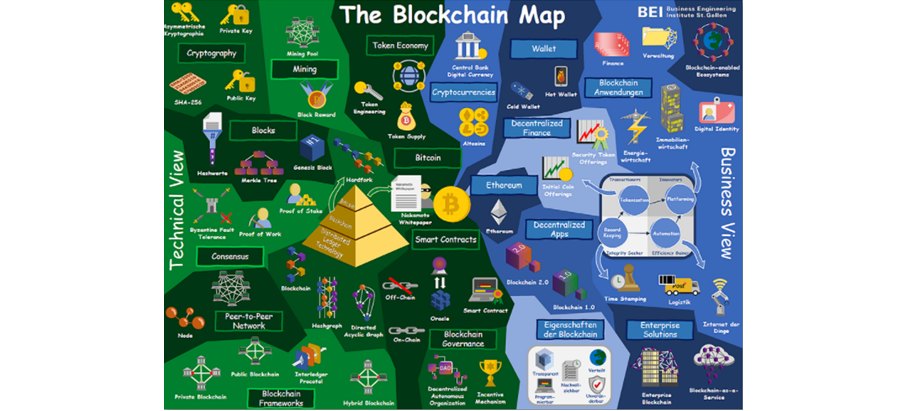
The Business Side of the Blockchain Map
Two weeks ago, we introduced the BlockWiki here on the blog, a website where we compile and explain the most important blockchain and DLT terms. The blockchain map, a graphical summary of blockchain terms, can also be purchased there. The overview differentiates between the technical and the business view of the Blockchain. After the left side with the technical view was described in detail in the blog post “The Technical Side of the Blockchain Map“, in this article we focus on the business view of the blockchain universe and explain the terms depicted there within their context.
To understand the business potential of the blockchain, we can start in the middle with Bitcoin. After all, since the publication of Satoshi Nakamoto’s whitepaper, the popularity of the blockchain has grown enormously precisely because of this cryptocurrency. This was followed by the development of numerous other cryptocurrencies, so-called altcoins, which include all currencies that are not based on physically existing means of exchange but on cryptography. Moreover, digital currencies of this form function through logic in a network and without a higher authority. Thus, they differ from central bank digital currencies, where the organization lies with central banks. Wallets are used to manage acquired cryptocurrencies. These can either be connected to the Internet as hot wallets or function offline as cold wallets. Besides Bitcoin, one of the best-known cryptocurrencies is Ethereum. However, Ethereum is not just a currency, but much more an open-source computing infrastructure, i.e. a programmable blockchain. With Ethereum’s own programming language “Solidity”, it is possible to develop decentralized applications, so-called DApps. DApps refer to applications in which at least one part, e.g. front-end or back-end, functions in a decentralized manner. Since the application is organized on a blockchain platform, the DApps benefit from the properties of the blockchain.
The unique selling points of the blockchain include traceability, as every action can be stored, and the immutability of the stored data in the blocks. Since blockchain technology can be classified as distributed ledger technology, it is based on a ledger that is stored in a distributed manner across all participants. Depending on the blockchain framework and needs, the stored information is transparently accessible to the entire public or to selected participants. This gives each participant the ability to verify the transactions themselves. Applications can be custom programmed based on the desired service solution on the blockchain, enabling automated operations.
To simplify the implementation of the blockchain in various business processes, companies can turn to enterprise blockchains. These blockchain implementations can be customized to meet the needs of businesses. Some of the most popular enterprise blockchains include Ethereum, Hyperledger, and Corda.
The use cases where blockchain is and can be applied can be divided into four areas: Tokenization, record keeping, automation and platforming.
- Tokenization refers to the digitization of all types of assets. Here, a token represents a product and enables access to all associated information and property rights. For example, tokens can be offered to document the ownership rights of a property, or tokens can be used as a kind of crowdfunding, i.e. to finance a business idea. This is called initial coin offering and falls under the umbrella term decentralized finance.
- In many blockchain use cases, the main purpose is the documentation of information, so-called record keeping. Tamper-proof record keeping in combination with timestamping adds rapid value to many use cases, as it is suitable not only for recording transaction data, but also, for example, for recording health data, property rights relating to assets and real estate, or information on the origin of merchandise.
- Especially in industry, blockchain is used for the digitalization and automation of processes. If there is no scope for decision-making, information that has been confirmed can be retrieved at any time in order to carry out the corresponding process steps. Automation is increasingly being used in the area of logistics and in combination with the Internet of Things (IoT).
- The blockchain is often used on platforms in interaction with other blockchains and the “off-chain” world. The resulting infrastructures, also called blockchain ecosystems, can be used to handle entire business processes. They are increasingly being used in the financial, real estate and energy industries. To use blockchain-based services in these industries, e.g. for credit approval, the user needs a digital identity, a digital representation of a legal or real person.
Further explanations of the individual terms can be found on the BlockWiki. We hope that we were able to give you a concise introduction to the topic of blockchain and DLT with the last two posts. We are happy to answer questions and comments in the comments section.
- The Business Side of the Blockchain Map - 28.05.2021
- The Technical Side of the Blockchain Map - 28.05.2021
- The BlockWiki – the Blockchain Explained - 14.05.2021
